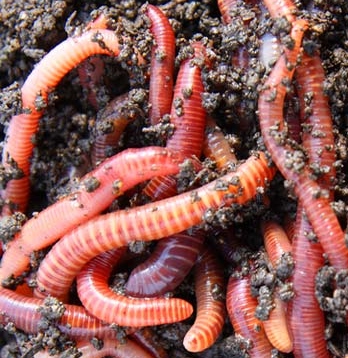Red Wiggler Express Fundamentals Explained
Red Wiggler Express Fundamentals Explained
Blog Article
Getting The Red Wiggler Express To Work
Table of ContentsRed Wiggler Express Fundamentals ExplainedGetting My Red Wiggler Express To WorkThe 2-Minute Rule for Red Wiggler ExpressThe Single Strategy To Use For Red Wiggler ExpressAn Unbiased View of Red Wiggler Express
Some worm farmers really hold back food and water to mimic dry spell conditions and bump up cocoon production. We do not advise this for the home composter as it has the potential to exterminate way too many of your ideal worms. Since you know all concerning the red worm it's time to go out and discover an excellent supplier and obtain a pound or 2 and begin your very own worm farm.We'll chat concerning just how to preserve red wigglers and why they must be the best worm for most composters. Enjoyable reality: The "fetid" component of the binomial name refers to what some say is a foul-smelling secretion the red wiggler uses to fend off killers. The anatomy of a red wiggler resembles that of other usual earthworms; a long-segmented body starts at the pointed head and ends at a slightly-flatted tail.
The smart Trick of Red Wiggler Express That Nobody is Discussing
The digestion tract is basic, starting at the mouth where the worm begins to eat its food before passing it on the pharynx. The pharynx is a muscle section which acts like a pump to draw food into the mouth prior to pumping it out into the esophagus. The esophagus is narrow and thin-walled and works as the "waiting room" for the gizzard.
Keep in mind: This demand for grinding is why grit is suggested in a worm container. The worm features no indigenous grinding capability so the worm depends on consumed grit to aid grind its food in the gizzard. The belly is where the very first chemical breakdown of food occurs with the help of a protein-busting enzyme.

Within 42 days, these baby worms will get to sex-related maturity as evidenced by the appearance of the clitellum. A fully grown red wiggler can be anticipated to live in between one to three years. The magnificent red wiggler might often be utilized as a bait worm for smaller fish or as a protein source for hens and reptiles.
A Biased View of Red Wiggler Express
And as discussed over, they are the most common composting worm in the globe. Rather, a mix of price, hardiness, and convenience in a wide variety of temperatures makes it the most suitable composting worm for the majority of new vermicomposters.
This is an usual practice among worm shippers who don't desire to take the chance of having the worms being in a warm or cool storage facility over the weekend break. Worm growers are not keeping worms in a scenario where they prepare to ship. The worms need to be collected from their habitat first, so cultivators will typically establish a Friday or Saturday deadline in order to harvest in time for a Monday shipment.
To reduce delivery price, you may wish to see if there are any neighboring "Mom and Pop" stores via a Google search. If you don't find what you're trying to find, after that I welcome you to take a look at worms through the Urban Worm Company! The amount of red wigglers you get need to be solely dependent upon the surface area you have readily available for vermicomposting.
I call these the "Huge 3" aspects of worm bin maintenance. If you keep all 3 within suitable arrays, then there's not * that * much that can fail with your bin. As discussed earlier, red wigglers have a large temperature level tolerance. For best outcomes, maintain a temperature level of 55F-90F. Brief separations out of that temperature level variety are fine.
The 20-Second Trick For Red Wiggler Express

For ideal outcomes, you intend to shoot for regarding 60-70% wetness level. The most basic examination for this is to press a handful as tough as you can. At the perfect wetness degrees which is simply under 70% that handful must hardly generate one decrease of fluid. pH in a worm bin is quite easy to preserve.


The European Nightcrawler, the larger relative of the red wiggler, is equally as voracious and additionally creates a good lure worm. However it chooses a bit of a cooler atmosphere than the red wiggler. The African Nightcrawler is a very huge composting worm and makes a beautiful, granular actors.
The Indian Blue is ravenous, yet likewise likes a warmer climate and it additionally displays a tendency to run away the bin. The red wiggler is a durable worm and isn't as particular about its environment. I such as to call it the Ford Taurus of vermicomposting worms; you won't boast to your hardcore composting buddies that you have them, but they will certainly offer you well.
The smart Trick of Red Wiggler Express That Nobody is Talking About
Surefire alive 1/2 pound of hand sorted Red Wigglers/Compost with worms (+500 worms) in various phases of life from cocoons to mature worms in their natural environment/bedding. Hand sorted worms reduced the disruption of the worms hence insuring live distribution. Red wiggler worms do not such as vibrations or light.
Report this page